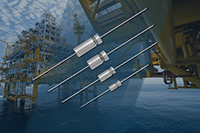source: Vishay news
MALVERN, Pa. — Jan. 15, 2018 — Vishay Intertechnology, Inc. (NYSE: VSH) today introduced a new series of HI-TMP® tantalum-cased, hermetically sealed wet tantalum capacitors with high temperature operation to +200 °C. Offering increased reliability for industrial and oil exploration applications, T34 series axial-leaded through-hole devices deliver increased mechanical shock and vibration withstand ability, along with longer life.
Optimized for timing, filtering, energy hold-up, and pulse power applications, the capacitors released today offer high vibration (sinusoidal: 80 g; random: 54 g) and mechanical shock (500 g) capabilities, while providing a long life of 1000 hours minimum at +200 °C. Offered in the A, B, C, and D case codes, the T34 series features voltage ratings from 25 VDC to 125 VDC, a wide capacitance range from 10 µF to 470 µF — with extensions planned to match current Vishay Sprague 134D series ratings — and capacitance tolerance of ± 10 % and ± 20 % standard.
The devices operate over a temperature range of -55 °C to +85 °C, to +200 °C with voltage derating, and provide maximum ESR down to 0.75 Ω at 120 Hz and +25 °C. RoHS-compliant, halogen-free, and Vishay Green, the capacitors offer both lead (Pb)-free and tin/lead (Sn/Pb) terminations.
Samples and production quantities of the T34 series are available, with lead times of 12 weeks for larger orders.































